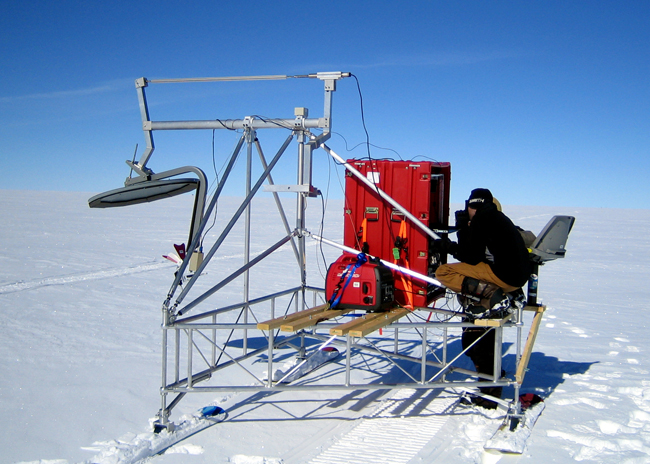|
The heat is onGeothermal flux beneath ice sheets may play significant role in meltingPosted January 24, 2008
The heat is on for polar ice sheets under stress from climate change – but not necessarily from where most people might think. Kees van der Veen, an associate professor at the University of Kansas in Lawrence and researcher with the Center for Remote Sensing of Ice Sheets (CReSIS), told a meeting of the American Geophysical Union in December that geothermal heat underneath the Greenland ice sheet might be responsible for rapid melting. An ice stream in the northeast is moving much faster than the rest of the ice and extends about 700 kilometers into the interior, according to van der Veen. Ice sheet models suggest the ice should be frozen to the bed below and moving much slower. However, the CReSIS researchers found a weakness in the crust using data gathered with the center’s airborne radar and U.S. Navy data on the gravitational pull over the ice sheet. “It’s about the thinnest in all of Greenland,” van der Veen said of the crust under the ice. The theory is that this thin crust is allowing more geothermal heat to escape, which is melting the ice and making it move much faster than it would otherwise. Van der Veen said he does not know why the crust is thinner at that particular part of the land mass, that perhaps tectonic plate motion caused it or it is simply a feature of the area. What is important, he said, is that current ice sheet models don’t properly account for geothermal heat flux when calculating melt and movement rates. There is reason to believe similar activity may be occurring under the ice sheets in Antarctica, he added. “For the most part, up until recently, the glaciologists ignored the geophysical activity beneath the ice sheets,” said van der Veen in a quote from the Lawrence Journal-World newspaper. Sridhar Anandakrishnan, an associate professor at Pennsylvania State University and science lead for CReSIS, said it is difficult to measure the temperature below the ice. To get that number, you have to know three things, he said – surface temperature, the snowfall rate and the heat coming up through the Earth’s crust. The first two factors are fairly easy to determine. The last one has been a guess up to this point. “It is a big gap, a big hole in the models,” Anandakrishnan said. Anandakrishnan said there are a couple of methods scientists can use to lock down the temperature. One of the trickier ways is to study the strength of radar waves as they reflect back to the surface, he explained. The bounce becomes weaker as the wave returns to the surface. “One of the reasons it gets weak is because of the temperature of the ice. When you have very warm ice, the attenuation of that radar wave is much larger,” he explained. However, the cold is only one variable that affects the wave signature, which makes it a difficult measurement to make. “But the folks at Kansas are pretty good about teasing out all the different variables, so I think we can make some assessment of temperature from the strength of the reflected radar energy,” Anandakrishnan said. Back to main story: CReSIS to Mold New Models. |



For USAP Participants |
For The Public |
For Researchers and EducatorsContact UsNational Science FoundationOffice of Polar Programs Geosciences Directorate 2415 Eisenhower Avenue, Suite W7100 Alexandria, VA 22314 Sign up for the NSF Office of Polar Programs newsletter and events. Feedback Form |


